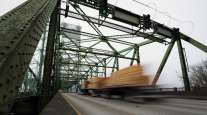Staff Reporter
FIU Bridge Collapse Unlikely to Dull Popularity of ABC Building Method, Experts Say

Despite urgent concerns over the cause of the recent collapse of a pedestrian bridge in Miami, experts agree that accelerated bridge construction (ABC) will remain a popular method for building spans.
The pedestrian bridge near Florida International University collapsed March 15, just days after it was installed. Six people were killed.

ABC streamlines the building process in an effort to reduce construction time, traffic disruption and costs. According to the Federal Highway Administration, ABC methods produce more durable bridges with longer service lives than conventional bridges and allow replacement within 48 to 72 hours rather than years.
There are more than 600,000 bridges in the country, according to government statistics. Anil Agrawal, a member of the American Society of Civil Engineers, estimates between 5% and 10% are built with ABC methods.
Agrawal said ABC methods will only grow in popularity because they create less disruption in urban areas. One of those methods commonly used is prefabricated construction, whereby structural components of a bridge are built elsewhere and include features that reduce the on-site construction time.
“ABC will continue to be popular because we don’t have a choice,” Agrawal said, adding that prefabrication is especially useful in cities because it poses a relatively small threat to congestion. For example, a complete bridge closure in a place such as New York City creates a “nightmare,” particularly for truckers making deliveries.
“We cannot afford to close bridges,” Agrawal said.
Scott Roux, national bridge practice lead for Michael Baker International, agreed, citing the value of efficient construction and rehabilitation projects in urban areas. Michael Baker International offers engineering and consulting services.

Millau Viaduct in Millau-Creissels, France by Martin Stone/Flickr
The tallest bridge in the world, France’s Millau Viaduct, was built using ABC methods, according to Roux. This cable-stayed bridge carries regular traffic, including trucks. Roux said ABC technologies are prevalent overseas, and have gained popularity in the United States over the past 20 years.
“Don’t expect it to diminish. It’s too valuable a tool, and it’s becoming too necessary in congested and urban areas,” Roux said.
Mike Arens, also at Michael Baker International in the Salt Lake City outpost, said the older practice of shutting down a road, setting girders and pouring concrete for the bridge deck on top of beams has too great an impact.
“You may have to shift traffic or reduce a lane. Traditional construction has been done for hundreds of years,” Arens said. Because ABC speeds the process, he said his firm typically reaches out to the trucking industry. “The lifeblood of the trucking industry is keeping traffic moving on time, getting your products delivered. Lane closures can really be a negative impact to the industry.”
Doug Hecox, spokesman for FHWA, said it will assist the National Transportation Safety Board in its analysis of what caused the pedestrian bridge in Miami to collapse. The agency is not willing to discount the entire ABC process because of this accident, he said.
“We don’t know what happened here yet. We don’t want to accuse this method as being responsible. It doesn’t look like it had anything to do with the construction method,” Hecox said. “It’s prefabrication, and prefabricated materials have been used since man began using bricks.”
Wassim Ghannoum, associate professor of civil engineering at the University of Texas at San Antonio, said the results of NTSB’s investigation may or may not slow the momentum of ABC.
“If clear negligence or error is found, then the impact should be minimal. If, however, the issue is found to be inherent to the proper design, then there will be a setback,” Ghannoum said. “But I feel ABC construction will still keep increasing and improving as it provides many benefits in terms of minimizing traffic disruptions.”



